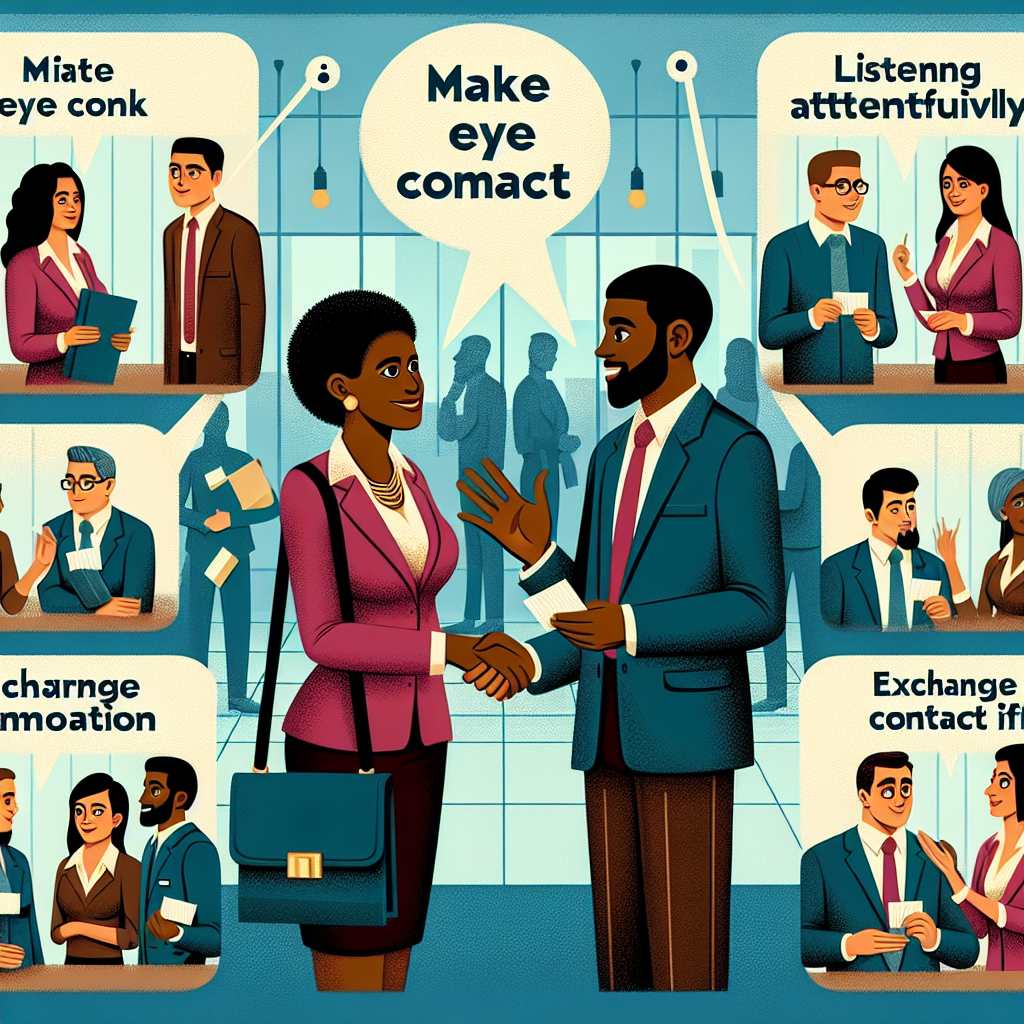
The Power of Authenticity: Building Genuine Relationships in Networking
Networking has become an essential skill in today’s professional world. It is the art of building and maintaining relationships that can help you advance in your career, find new opportunities, and even make new friends. However, many people struggle with networking because they see it as a superficial and insincere way of making connections. The truth is, networking can be a powerful tool if done authentically and with genuine intentions.
The key to successful networking lies in building genuine relationships. This means going beyond the surface level and truly getting to know the people you meet. It’s about creating a connection based on mutual interests, values, and goals. When you approach networking with authenticity, you will not only make meaningful connections, but you will also enjoy the process.
The first step in building genuine relationships through networking is to be yourself. It may sound cliché, but it’s true. People can sense when someone is being fake or trying too hard. Instead of putting on a facade, be genuine and let your personality shine. This will make you more approachable and relatable, and people will be more likely to remember you.
Another important aspect of authenticity in networking is being honest and transparent. Don’t try to impress others with exaggerated stories or accomplishments. Instead, be open about your experiences, both successes and failures. This will make you more relatable and show that you are a real person, not just a polished professional.
In addition to being yourself and honest, it’s also crucial to show genuine interest in others. When you meet someone, ask them about their work, interests, and goals. Listen attentively and ask follow-up questions. This will not only help you get to know the person better, but it will also show that you value their thoughts and opinions. People appreciate when someone takes a genuine interest in them, and it can lead to a deeper connection.
Another way to build genuine relationships in networking is to be vulnerable. This may seem counterintuitive, as vulnerability is often seen as a weakness. However, when you open up and share your vulnerabilities with others, it shows that you trust them and are willing to be authentic. This can create a sense of camaraderie and trust, which are essential for building strong relationships.
It’s also important to remember that networking is a two-way street. It’s not just about what you can gain from others, but also what you can offer. Be willing to share your knowledge, skills, and connections with others. This will not only make you a valuable contact, but it will also show that you are genuinely interested in helping others succeed.
In addition to these tips, it’s also essential to follow up and stay in touch with the people you meet through networking. Building genuine relationships takes time and effort, and it’s important to nurture them. Send a follow-up email or connect on social media to stay in touch. This will show that you value the connection and are interested in maintaining it.
Lastly, don’t be afraid to be yourself and have fun while networking. It doesn’t have to be a formal and stuffy event. Find networking opportunities that align with your interests and hobbies. This will make it easier to connect with others and build genuine relationships. Remember, networking is not just about advancing your career, but also about making meaningful connections with like-minded individuals.
In conclusion, mastering the art of networking is all about building genuine relationships. Be yourself, be honest and transparent, show genuine interest in others, be vulnerable, and be willing to give as much as you receive. By following these tips, you can make networking a more enjoyable and authentic experience, and build connections that can benefit you both personally and professionally. So go out there, be yourself, and start making meaningful connections!
Maximizing Networking Events: Strategies for Making the Most of Every Opportunity
Networking events can be intimidating for many people, but they are also a great opportunity to make meaningful connections and expand your professional network. Whether you are attending a conference, a job fair, or a social event, there are certain strategies you can use to maximize your networking experience. In this article, we will discuss some tips for making the most out of every networking opportunity.
First and foremost, it is important to have a clear goal in mind when attending a networking event. Are you looking for a new job? Do you want to meet potential clients or collaborators? Having a specific goal will help you focus your efforts and make the most of your time at the event. It will also give you a sense of purpose and confidence, which can be helpful when approaching new people.
Another important tip is to do your research beforehand. Find out who will be attending the event and do some background research on them. This will not only help you identify potential connections, but it will also give you some conversation starters. You can also research the event itself and familiarize yourself with the schedule and any speakers or panelists. This will help you make the most of your time and ensure that you don’t miss any important opportunities.
When you arrive at the event, make sure to dress professionally and have a positive attitude. Your appearance and demeanor can make a big impression on others and can help you stand out in a sea of people. Smile, make eye contact, and be approachable. Remember, networking is all about building relationships, so be friendly and genuine in your interactions.
One of the most important aspects of networking is listening. When you meet someone, ask them about themselves and their work. Show genuine interest and actively listen to what they have to say. This will not only help you build a connection with them, but it will also give you valuable insights and information. Remember, networking is not just about promoting yourself, but also about learning from others.
Another effective strategy for maximizing networking events is to have a well-crafted elevator pitch. This is a brief introduction of yourself and your professional background that you can use when meeting new people. Keep it concise, engaging, and tailored to the event or industry you are in. Practice your elevator pitch beforehand so that you can deliver it confidently and make a strong first impression.
In addition to meeting new people, networking events are also a great opportunity to reconnect with old contacts. Make sure to reach out to any previous colleagues, classmates, or mentors who may be attending the event. This can be a great way to catch up and potentially even collaborate on future projects.
Lastly, don’t forget to follow up after the event. This is a crucial step that many people overlook. Send a personalized email or LinkedIn message to the people you met, thanking them for their time and mentioning something specific that you discussed. This will help solidify the connection and keep the conversation going. You can also connect with them on social media and stay updated on their professional endeavors.
In conclusion, networking events can be a valuable opportunity to make meaningful connections and expand your professional network. By setting clear goals, doing your research, being approachable, actively listening, having a well-crafted elevator pitch, reconnecting with old contacts, and following up, you can make the most out of every networking opportunity. Remember, networking is not just about promoting yourself, but also about building relationships and learning from others. So go out there, be confident, and make meaningful connections!
The Art of Small Talk: How to Start Conversations and Keep Them Going
Networking is an essential skill in today’s professional world. It is the key to building meaningful connections and opening doors to new opportunities. However, for many people, the thought of networking can be intimidating. The idea of starting conversations with strangers and keeping them going can be daunting. But fear not, mastering the art of small talk is easier than you think. With a few tips and tricks, you can become a pro at starting conversations and keeping them flowing.
The first step to mastering the art of small talk is to have a positive attitude. Approach networking events with an open mind and a friendly demeanor. Remember, everyone is there for the same reason – to make connections. So, don’t be afraid to introduce yourself and strike up a conversation. A smile and a confident handshake can go a long way in making a good first impression.
Another important aspect of small talk is to have a few conversation starters in your arsenal. These can be simple questions like, ”What brings you to this event?” or ”How do you know the host?” These questions are easy to answer and can lead to more in-depth conversations. It’s also helpful to have some general topics in mind, such as current events, sports, or hobbies. This will give you something to talk about if the conversation starts to lag.
When starting a conversation, it’s essential to listen actively. Pay attention to what the other person is saying and ask follow-up questions. This shows that you are genuinely interested in what they have to say and can help keep the conversation going. Avoid interrupting or dominating the conversation. Remember, networking is about building relationships, not just talking about yourself.
One of the most challenging aspects of small talk is keeping the conversation going. It’s natural for conversations to have lulls, but it’s essential to keep the momentum going. One way to do this is by asking open-ended questions. These are questions that cannot be answered with a simple yes or no. They require the other person to give a more detailed response, which can lead to a more engaging conversation.
Another tip for keeping the conversation flowing is to find common ground. Look for shared interests or experiences that you can both relate to. This can help build a connection and make the conversation more meaningful. However, be careful not to force commonalities. If you can’t find any, it’s okay to move on to a different topic.
It’s also crucial to be aware of your body language during small talk. Nonverbal cues can speak volumes and can make or break a conversation. Make sure to maintain eye contact, smile, and have an open posture. This shows that you are engaged and interested in the conversation. Avoid crossing your arms or looking around the room, as this can make you appear disinterested.
Lastly, don’t be afraid to end the conversation gracefully. It’s okay to excuse yourself and move on to talk to someone else. You can say something like, ”It was great talking to you, but I don’t want to take up too much of your time. Enjoy the rest of the event!” This shows that you respect the other person’s time and allows you to continue networking with others.
In conclusion, mastering the art of small talk is all about having a positive attitude, being prepared with conversation starters, actively listening, and finding common ground. With these tips in mind, you can confidently start conversations and keep them going at networking events. Remember, networking is about building relationships, so don’t be afraid to be yourself and have fun with it. Happy networking!
Leveraging Social Media: Using Online Platforms to Expand Your Network
Networking has become an essential skill in today’s professional world. It’s not just about who you know, but also about who knows you. Building a strong network can open doors to new opportunities, collaborations, and valuable connections. While traditional networking events and face-to-face interactions are still important, leveraging social media has become a game-changer in expanding your network.
With the rise of social media platforms, networking has become more accessible and convenient. It allows you to connect with professionals from all over the world, regardless of time and location. However, with so many platforms available, it can be overwhelming to know where to start. Here are some tips for using social media to expand your network and make meaningful connections.
First and foremost, it’s crucial to have a professional online presence. Your social media profiles should reflect your personal brand and showcase your skills and expertise. Use a professional headshot as your profile picture and ensure that your bio is up-to-date and accurately represents your professional goals. This will make it easier for others to find and connect with you.
LinkedIn is the go-to platform for professional networking. It’s a virtual resume and a powerful tool for building connections. Start by connecting with people you know, such as colleagues, classmates, and friends. Then, expand your network by joining relevant groups and participating in discussions. This will help you connect with like-minded professionals and showcase your knowledge and expertise.
Twitter is another platform that can be leveraged for networking. It’s a great way to engage with industry leaders and experts. Follow professionals in your field and engage with their content by liking, retweeting, and commenting. This will help you get noticed and start conversations with people you may not have had the opportunity to meet in person.
Instagram may not be the first platform that comes to mind when thinking about networking, but it can be a powerful tool if used correctly. Use hashtags to connect with professionals in your industry and engage with their content. You can also use Instagram to showcase your work and build your personal brand. Share behind-the-scenes photos, projects you’re working on, and your professional achievements. This will help you stand out and attract potential connections.
Apart from these popular platforms, there are also niche platforms that cater to specific industries and professions. For example, Behance is a platform for creatives to showcase their work, while GitHub is a platform for developers to collaborate and showcase their coding skills. Research and find platforms that are relevant to your field and join them to connect with professionals in your industry.
While social media is a great way to expand your network, it’s important to remember that it’s not just about collecting connections. Building meaningful relationships takes time and effort. Take the time to engage with your connections, share valuable content, and offer help and support when needed. This will help you build a strong network of professionals who can vouch for your skills and expertise.
In addition to expanding your network, social media can also be used to stay updated on industry news and trends. Follow thought leaders and industry publications to stay informed and share your thoughts and insights. This will not only help you stay relevant but also position you as a knowledgeable and engaged professional in your field.
In conclusion, leveraging social media is a valuable tool for expanding your network and making meaningful connections. Remember to maintain a professional online presence, engage with others, and use the platforms to stay updated on industry news and trends. With these tips, you’ll be on your way to mastering the art of networking and building a strong and valuable network.
Following Up Effectively: Turning Connections into Long-Term Relationships
Networking is a crucial skill in today’s professional world. It is not just about exchanging business cards and making small talk at events, but rather about building meaningful connections that can lead to long-term relationships. In the previous section, we discussed the importance of making a good first impression and how to effectively network at events. However, the real work begins after the initial meeting. In this section, we will delve into the art of following up effectively and turning those connections into lasting relationships.
The first step in following up effectively is to have a clear understanding of your goals. What do you hope to achieve by connecting with this person? Is it a potential business partnership, a mentorship, or simply expanding your network? Having a clear goal in mind will help guide your follow-up strategy.
One of the most important things to remember when following up is to do it in a timely manner. Don’t wait too long after the initial meeting to reach out. A good rule of thumb is to follow up within 24-48 hours. This shows that you are genuinely interested in maintaining the connection and that you value their time.
When reaching out, it is important to personalize your message. Avoid generic emails or messages that could be sent to anyone. Mention something specific from your initial conversation to show that you were actively listening and that you remember the details. This will make the recipient feel special and increase the chances of a response.
Another effective way to follow up is to offer something of value. This could be an article or resource related to a topic you discussed, an introduction to someone in your network who could be beneficial to them, or even a small gesture like sending a thank-you note. By offering something of value, you are showing that you are invested in the relationship and not just looking for something in return.
In addition to following up after the initial meeting, it is important to stay in touch regularly. This could be through email, social media, or even meeting up for coffee or lunch. The key is to maintain a consistent presence without being too pushy or overbearing. This will keep the connection alive and show that you are genuinely interested in building a relationship.
One of the biggest mistakes people make when following up is only reaching out when they need something. This can come across as insincere and can damage the relationship. Instead, make an effort to stay in touch and offer support or assistance whenever possible. This will show that you value the relationship and are willing to give as much as you take.
Another important aspect of following up effectively is to be genuine and authentic. People can sense when someone is being disingenuous or only interested in their own gain. Be sincere in your interactions and show a genuine interest in the other person. This will help build trust and strengthen the relationship.
Lastly, don’t be afraid to ask for what you want. If you have a specific goal in mind, don’t be shy about expressing it. However, make sure to do so in a respectful and professional manner. Be clear about what you are asking for and why it is important to you. This will show that you are serious about the relationship and that you value their input.
In conclusion, following up effectively is crucial in turning connections into long-term relationships. It requires a combination of timely and personalized communication, offering value, staying in touch regularly, being genuine and authentic, and being clear about your goals. By mastering the art of following up, you can build a strong network of meaningful connections that can benefit you both personally and professionally. Remember, networking is not just about what you can get, but also about what you can give. So, go out there and start building those lasting relationships!
We have lots of exciting coming events in Entrepreneurship, Investing and Personal Development. You can find them all here:
www.swedishwealthinstitute.se/events




